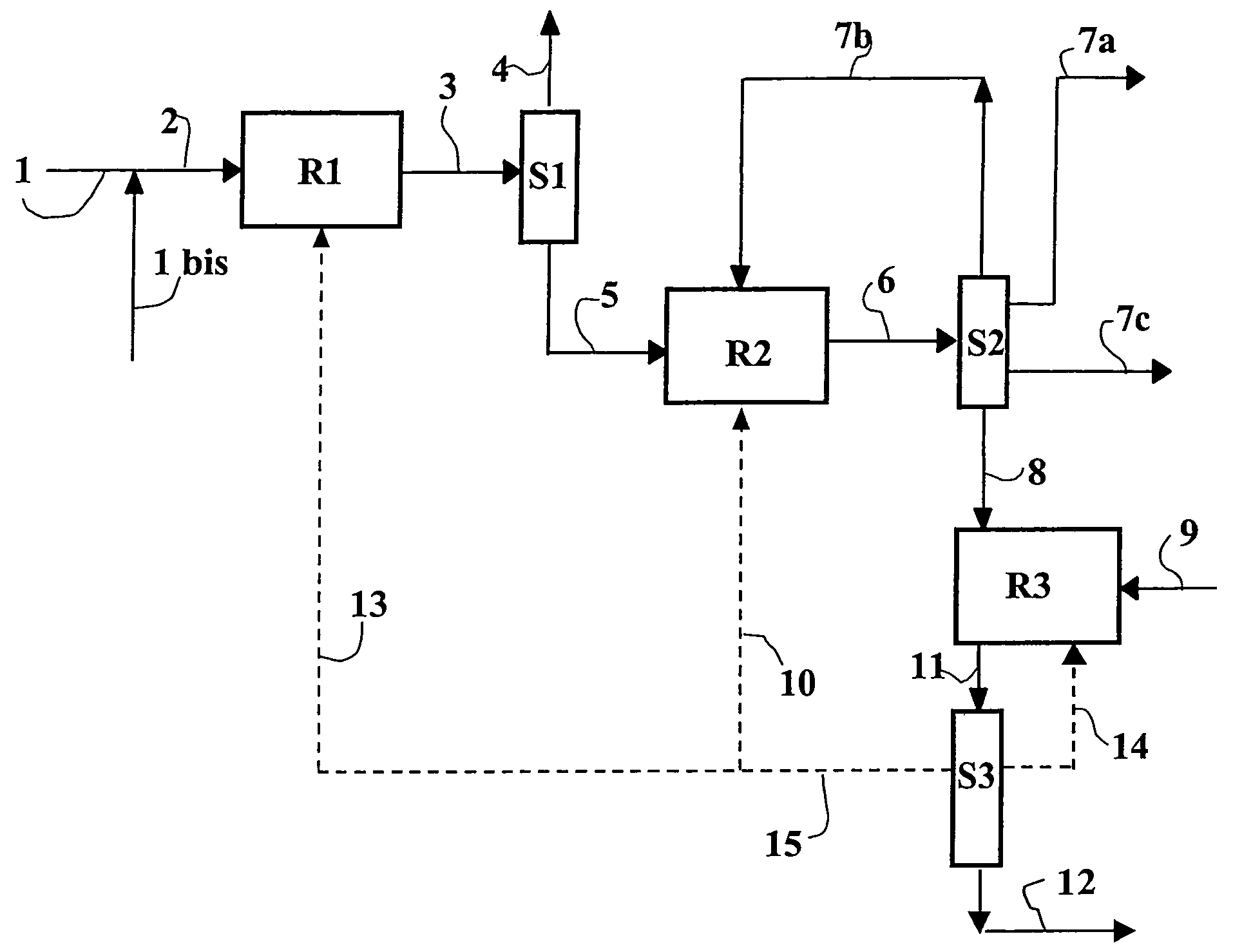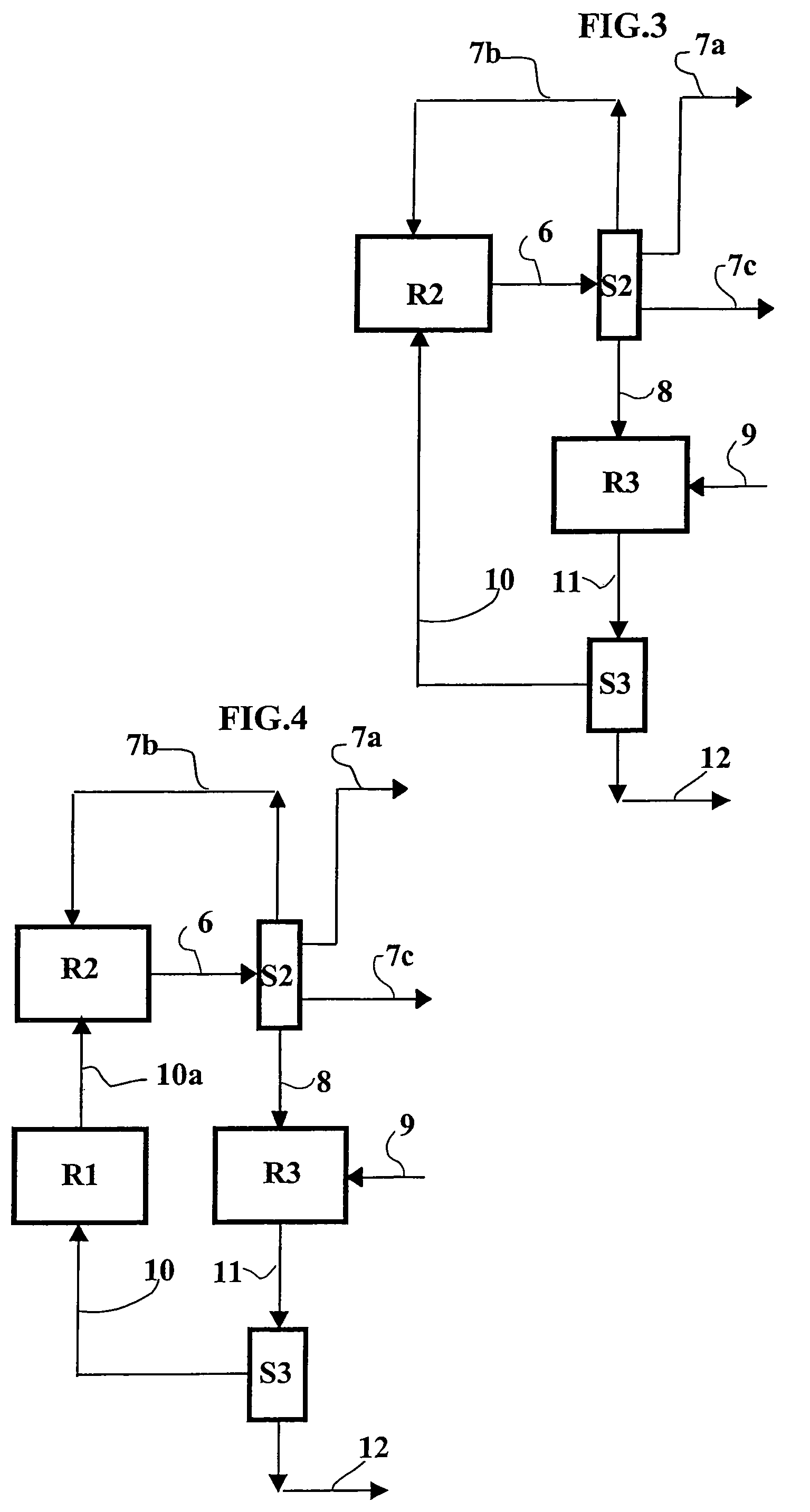Method for jointly producing propylene and petrol from a relatively heavy charge
a technology of propylene and petrol, which is applied in the field of jointly producing propylene and petrol from a relatively heavy charge, can solve the problems that the fractions cannot be easily recycled to the fcc to increase the propylene yield, and adjustment is not possibl
- Summary
- Abstract
- Description
- Claims
- Application Information
AI Technical Summary
Benefits of technology
Problems solved by technology
Method used
Image
Examples
example 2
According to the Invention
[0173]A C5 cut from a steam cracker, comprising mostly butadiene, is treated according to the process of the present invention in an installation such as that described in FIG. 1. Said C4 cut is hydrogenated selectively in R1 and the light compounds, in particular the residual hydrogen and the light gases such as methane are removed in the separation section S1. The C4 cut resulting from this hydrogenation (flow 5) is introduced into the oligomerization reactor R2 which operates in the following conditions:
[0174]
Pressure:5.5 MPaTemperature:220° C.HSV:1 h−1
[0175]The catalyst used is a type MFI zeolite with an Si / Al ratio of 48. It is used in the form of spheres with average diameter of 2 mm.
[0176]The flow leaving oligomerization contains 90% of oligomers relative to the olefins of the feedstock, mainly C8 olefinic oligomers, in smaller quantities of C12.
[0177]The quantity of oligomers introduced in catalytic cracking represents 10 wt. % of the total feedstoc...
example 3
According to the Invention, Shown in FIG. 1
[0179]A C4 cut obtained from a steam cracker is treated according to the process of the present invention. This is a cut of the same kind as that used in Example 2, but the quantity of oligomers introduced in the catalytic cracking stage at present represents 18% of the catalytic cracking feedstock. The operating conditions of the oligomerization reactor and of the FCC reactor are the same as in Example 2. The propylene yield is 7.6% and the gasoline yield is 38.9%.
example 4
According to the Invention, Shown in FIG. 1
[0180]The same C4 cut as that used in Examples 2 and 3 is treated according to the process of the present invention. The quantity of oligomers from the fresh external feedstock (from oligomerization of the steam cracked cut) introduced in the catalytic cracking stage represents 10% of the catalytic cracking feedstock. The oligomerization stage still operates with the conditions of Examples 2 and 3. The catalytic cracking still operates in the conditions of Example 1. In this Example 4, the C4 cut from the catalytic cracking stage is recycled to the oligomerization stage, to increase the quantity of cracked oligomers.
[0181]The propylene yield is 8.3% and the gasoline yield is 42.7%.
PUM
| Property | Measurement | Unit |
|---|---|---|
| boiling point | aaaaa | aaaaa |
| boiling point | aaaaa | aaaaa |
| wt. % | aaaaa | aaaaa |
Abstract
Description
Claims
Application Information
 Login to View More
Login to View More - R&D
- Intellectual Property
- Life Sciences
- Materials
- Tech Scout
- Unparalleled Data Quality
- Higher Quality Content
- 60% Fewer Hallucinations
Browse by: Latest US Patents, China's latest patents, Technical Efficacy Thesaurus, Application Domain, Technology Topic, Popular Technical Reports.
© 2025 PatSnap. All rights reserved.Legal|Privacy policy|Modern Slavery Act Transparency Statement|Sitemap|About US| Contact US: help@patsnap.com



